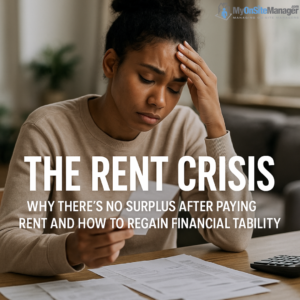In today’s economic landscape, skyrocketing rent prices have left millions of individuals and families struggling to make ends meet. The rising cost of housing has outpaced wage growth in many regions, leaving renters with little to no disposable income after paying for their monthly living expenses. With inflation and stagnant wages, the financial burden is heavier than ever, leading to economic insecurity, reduced savings, and limited financial growth.
This blog post explores the root causes of this crisis, its impact on renters, and practical strategies to manage rent expenses effectively.
Understanding the Rent Burden: The 30% Rule No Longer Works
Traditionally, financial advisors have recommended that no more than 30% of a person’s gross income should go toward housing costs, including rent and utilities. This benchmark was intended to ensure that renters had enough money left over for other essentials like food, transportation, healthcare, and savings. However, with rental prices skyrocketing in major cities and suburban areas, the 30% rule is becoming increasingly unrealistic.
According to a recent housing market report, the median rent for a one-bedroom apartment in the United States is $1,700 per month, while a two-bedroom unit averages around $1,900. Meanwhile, the median household income hasn’t kept pace with these costs, making it impossible for many people to follow the 30% guideline.
As a result, renters are being forced to spend 40%, 50%, or even over 60% of their income on housing alone. This leaves little to no financial buffer for emergencies, investments, or even basic living necessities.
Why Are Rent Prices So High?
There are multiple reasons why rent prices have become unaffordable for many people:
1. Supply & Demand Imbalance
The demand for rental units has outpaced the available supply, especially in urban areas. With fewer affordable housing options, landlords can increase rent prices without much pushback.
2. Inflation & Cost of Living Increases
Inflation has caused the cost of goods and services to rise, and housing is no exception. Property taxes, maintenance costs, and insurance rates have increased, prompting landlords to pass these costs on to tenants.
3. Investor-Owned Rental Properties
In many cities, private equity firms and corporate investors have bought up large numbers of properties, converting them into high-priced rentals. These companies prioritize profit over affordability, often pricing out middle and lower-income renters.
4. Wage Stagnation
While rent prices have climbed steadily over the past decade, wages have remained relatively stagnant. This gap between earnings and living costs has made it increasingly difficult for individuals and families to afford housing without financial strain.
The Consequences of High Rent on Everyday Life
Spending a disproportionate amount of income on rent has far-reaching effects, including:
- Lack of Savings – Many renters are unable to save for emergencies, retirement, or homeownership because their income is stretched thin.
- Debt Accumulation – People may rely on credit cards or loans to cover other necessary expenses, leading to long-term financial instability.
- Delayed Life Milestones – High rent costs can prevent individuals from achieving financial independence, starting a family, or investing in a home.
- Increased Stress & Mental Health Issues – The financial strain of high rent can lead to anxiety, depression, and overall reduced quality of life.
How to Navigate the Rent Crisis & Regain Financial Stability
If you’re struggling to keep up with rising rental costs, here are some practical strategies to help you regain financial control:
1. Negotiate Your Rent
Many renters don’t realize that rent is often negotiable. If you’re a reliable tenant, consider discussing a lease extension or a lower monthly rate with your landlord. Pointing out market trends, competing rental prices, or offering to sign a longer lease could work in your favor.
2. Relocate to a More Affordable Area
If possible, explore moving to a more affordable city or neighborhood where rent prices are lower. Remote work opportunities have made it easier for many people to live in cheaper areas without sacrificing career prospects.
3. Look for Rental Assistance Programs
Many states and local governments offer rental assistance programs to help tenants cover housing costs. Research programs in your area to see if you qualify for subsidies, vouchers, or grants.
4. Consider Alternative Housing Options
If traditional renting isn’t working for you, consider:
- Co-living spaces that provide affordable shared housing.
- House hacking, where you rent out a portion of your living space to offset costs.
- Moving in with family to save money while building financial stability.
5. Adjust Your Budget & Expenses
While rent might take up a significant portion of your income, reworking your budget could help ease financial stress. Try:
- Cutting down on non-essential expenses like subscriptions, dining out, or unnecessary shopping.
- Using a budgeting tool to track spending and savings more effectively.
- Allocating extra income towards a rental savings fund to cover future increases.
6. Explore Rent Control & Tenant Rights
Certain cities have rent control laws that limit how much landlords can increase rent annually. Research local housing regulations to understand your rights and fight against unfair rent hikes if necessary.
Final Thoughts: Is Affordable Housing Still Possible?
The rising cost of rent has made financial stability a major challenge for millions of people worldwide. However, by exploring alternative living arrangements, negotiating rent, and utilizing financial resources, renters can take proactive steps toward affordability.
As we move forward, policymakers, landlords, and tenants must work together to address the affordable housing crisis and ensure that stable, reasonably priced housing remains accessible for all.

